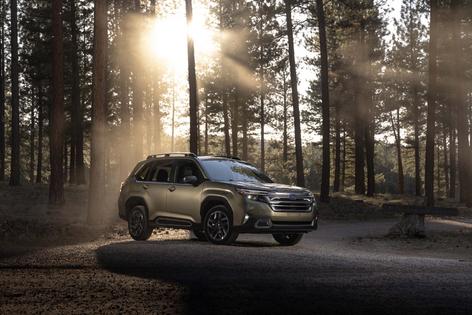Eric's Autos: 2025 Subaru Forester
The Forester is one of Subaru's most important models -- to Subaru, in that it is one of Subaru's bestselling models. For this reason it's really important -- to Subaru -- to not fix what isn't broken.
That's always a risk whenever a model that sells well as it is gets redesigned. Of course, not redesigning it also runs the risk of it getting old and, for that reason, not selling well.
You see the problem.
Has the just-updated Forester solved it?
What It Is
The Forester is a compact crossover with two rows and seating for five. It differs from the others in its class, such as the Honda CR-V, Toyota RAV4 and Hyundai Tucson (among many others), in that it is the only crossover you can buy -- that isn't a Porsche -- that has a boxer engine rather than an inline engine. It also comes standard with more ground clearance (8.7 inches) than most, which -- along with standard all-wheel drive -- makes it more able to deal with deep snow and uneven terrain, such as washed-out dirt/gravel roads, than most of the rest.
Prices for the just-updated 2025 model begin at $29,995 for the base trim. There are several other trims, including Premium ($33,385), Sport ($36,105), Limited ($37,695), Touring ($41,595) and Wilderness ($36,285).
A hybrid drivetrain is available with Premium, Limited and Touring trims, the latter stickering for $43,2945.
What's New for 2025
The Forester gets a major cosmetic makeover, outside and in -- and a new (optional) hybrid drivetrain.
What's Good
-- Boxer engine is something different in a class where too much is pretty much the same.
-- More standard ground clearance -- and even more clearance is available (9.2 inches with Wilderness trim).
-- Can pull up to 3,000 pounds -- more than most of the others in the class.
What's Not So Good
-- Significant increase (almost $3,000) in base price versus last year.
-- The only version rated to pull 3,000 pounds is the Wilderness trim.
-- No optional engine -- or transmission.
Under the Hood
Every Forester -- including the new hybrid version -- comes standard with a 2.5-liter, horizontally opposed or boxer engine. This type of engine lies flat rather than stands upright, and its cylinders (pistons) are divided in pairs of two -- in this case -- on each side that box each other from opposite sides of the crankshaft, as opposed to being lined up in a row and going straight up and down. The advantages of the boxer layout are that the weight of the engine is spread out low down in the car's chassis, which improves balance and handling. This is one reason why Porsches have this kind of engine. The boxer engine is itself also more balanced because the "boxing" pistons cancel out what would otherwise be vibrations needing balancing weights to do the same -- so the boxer engine is also lighter and smoother.
The Forester's 2.5-liter engine is also not a turbocharged engine, because it's a larger engine than has become in other small crossovers and doesn't need the boost.
The big upside to not having a small, turbo-boosted engine is not ever having to worry about having to pay for a replacement turbo. And a decreased likelihood of ever having to worry about paying to fix or replace a prematurely worn-out engine.
The downside -- as regards the Forester -- is that there's no optional engine unless you count the hybridized version of the 2.5-liter engine. It's the same engine but gets shut off automatically whenever possible by the system, as when the car's not actually moving or when it is decelerating/coasting. During these times, the lithium battery powers accessories, and (as in other hybrids) a small electric motor allows the vehicle to move for short distances at low speeds without the engine on while also boosting the combined output of the ensemble to 194 horsepower and increasing the touted gas mileage to 35 mpg city, 34 mpg highway.
This savings on gasoline is however offset by the considerably higher cost of the hybrid drivetrain, which also requires buying the higher-cost Premium trim. This, the least-expensive hybrid Forester, costs $36,595, or $6,600 more than the base-trim, nonhybrid Forester. It is doubtful you'll ever see a net savings -- on what you spend to own the car versus what it costs to drive it -- but you do get a 14-horsepower bump for the money.
All Foresters -- like all Subarus (except for the BRZ sports coupe) -- come standard with AWD and a continuously variable transmission with driver-selectable modes.
On the Road
The Forester is soft and comfortable. It does not try to be like the WRX. While the latter is hell-on-wheels in the snow (and the dirt and gravel) due to its tenaciously grippy AWD system and high-powered turbocharged engine, it is not the hot ticket for rutted dirt/gravel roads or several inches of standing water -- because it only has 5.4 inches of ground clearance.
Because it is a performance car.
The Forester has 8.7 inches of ground clearance; the Wilderness ups that to more than 9 inches. That latter is nearly twice the WRX's clearance, and that means a lot of air between the Forester's vulnerable underside and the rocks and other such objects that would otherwise potentially put a dent in the floorpans or just break/tear off some other thing. That generous ground clearance, even more than the AWD, is what makes the Forester a particularly practical vehicle.
That's of course not exciting -- in the usually meant sense. But it is exciting to people who like a particularly practical vehicle.
At the Curb
The 2025 Forester is only a little larger overall than the 2024 Forester (183.3 inches end to end for the '25 versus 182.7 inches for the '24), but it looks more substantial. More finely, it looks more like an SUV than a crossover -- even though it still is exactly that, meaning it is not based on a four-wheel-drive truck chassis. The makeover seems to be meant to make the Forester more appealing to buyers who prefer the more rugged look of an SUV. The SUV-like ground clearance and body cladding around the perimeter helps with that.
Of course, the main thing most people who buy crossovers rather than truck-based SUVs is that crossovers have more room inside than a same-sized SUV -- on account of the flatter floorpans that crossovers have because they don't have the bulky rear axles, two-speed transfer cases and heavier duty underthings for which space has to be made.
That's the main reason why this compact crossover has 27.5 cubic feet of space for stuff behind its second row and 69.1 cubic feet when the second row's folded down. To get a sense of this, a Jeep Wrangler -- which is an SUV -- only has 12.9 cubic feet of space behind its backseats and the total available cargo space is just 31.7 cubic feet, only a little bit more space than the Soobie has behind its backseats (and with passengers riding back there). The backseats in a crossover almost always have more legroom and headroom too -- chiefly (again) because the floorpans are lower and because there's more space for legs because space didn't have to be used for things under the floorpans.
Relative to others in its class, the Soobie has significantly more backseat legroom -- 39.4 inches -- than the Toyota RAV4 (37.8 inches) though not as much as the class-best Hyundai Tucson (41.3 inches). The Honda CR-V comes out on top versus the others in terms of maximum cargo space: 39.3 inches behind the backseats and 76.5 inches total.
The Rest
All but the base trim Forester come standard with a new/larger 11.6-inch LCD touch screen, which is easier to use than many because there are manual knobs for the volume and station-tuning, so you do not have to look at the screen to make changes while you're trying to keep your eyes on the road.
The Bottom Line
The main not-so-great thing is the new Forester's price, which is almost $3,000 higher now. Yes, it's new -- and nicer in some ways. But like its rivals, the new Forester is less affordable than it was -- and not by a little, either.
========
Eric's latest book, "Doomed: Good Cars Gone Wrong!" will be available soon. To find out more about Eric and read his past columns, please visit the Creators Syndicate webpage at www.creators.com.
Copyright 2025 Creators Syndicate, Inc.








Comments